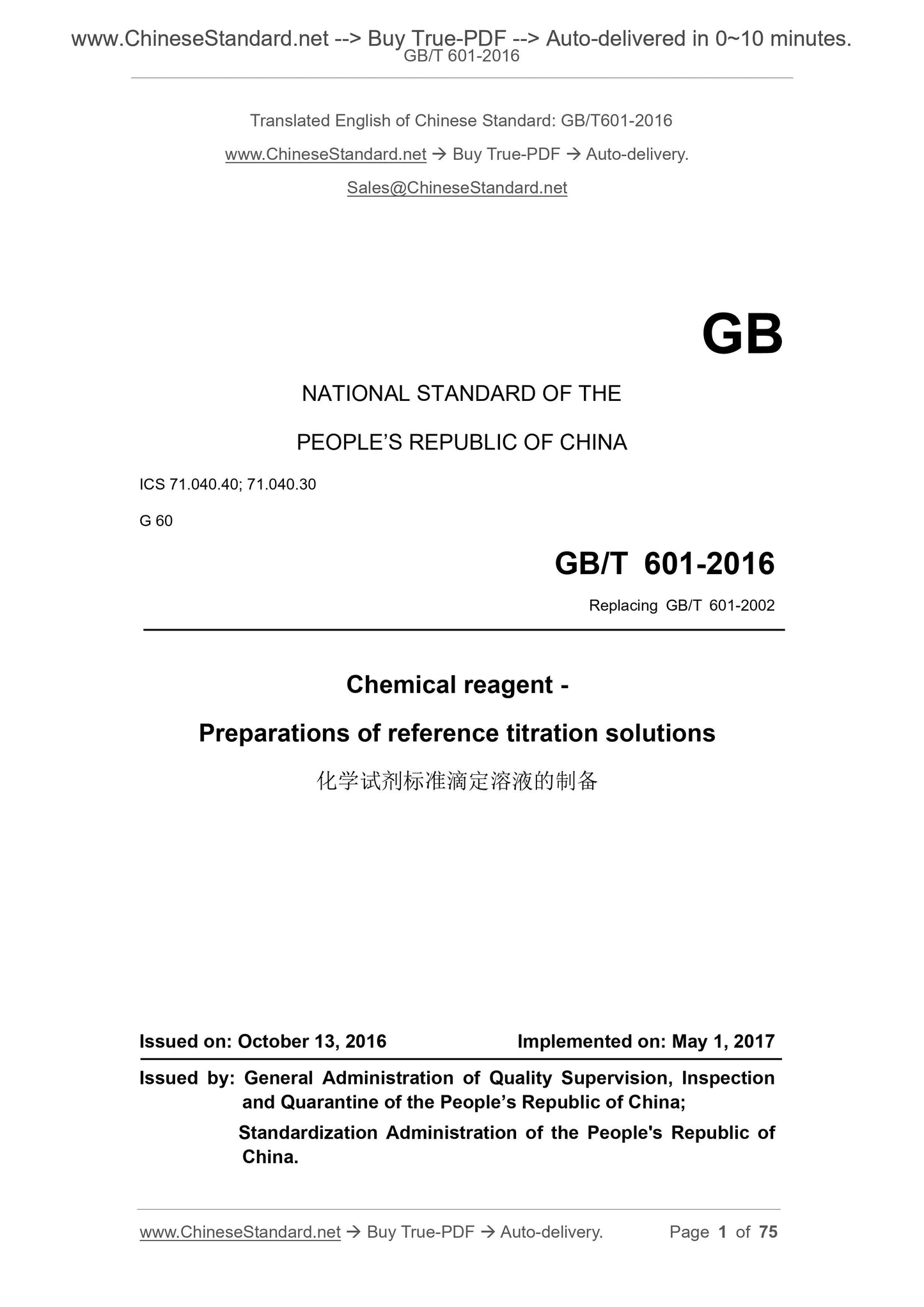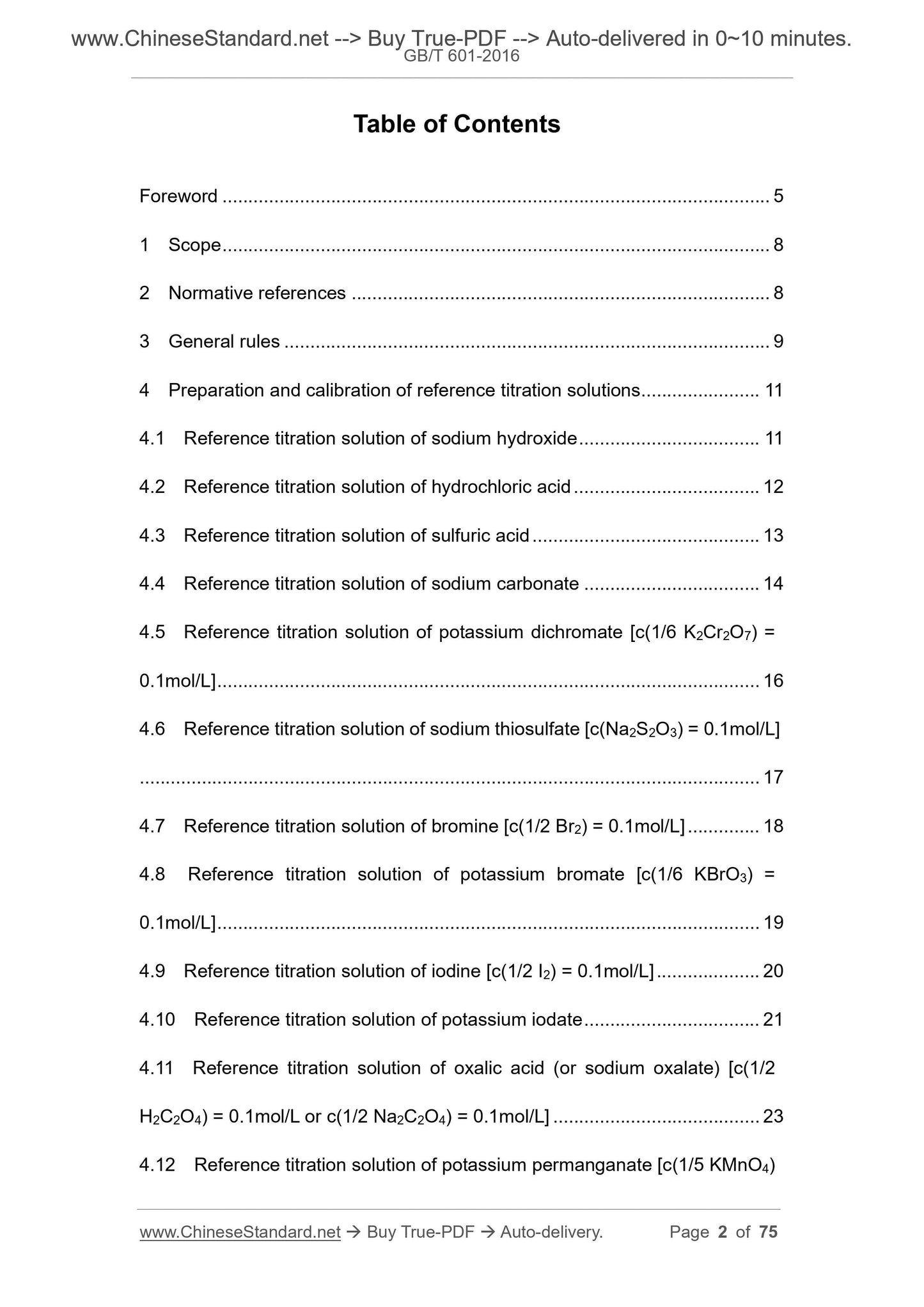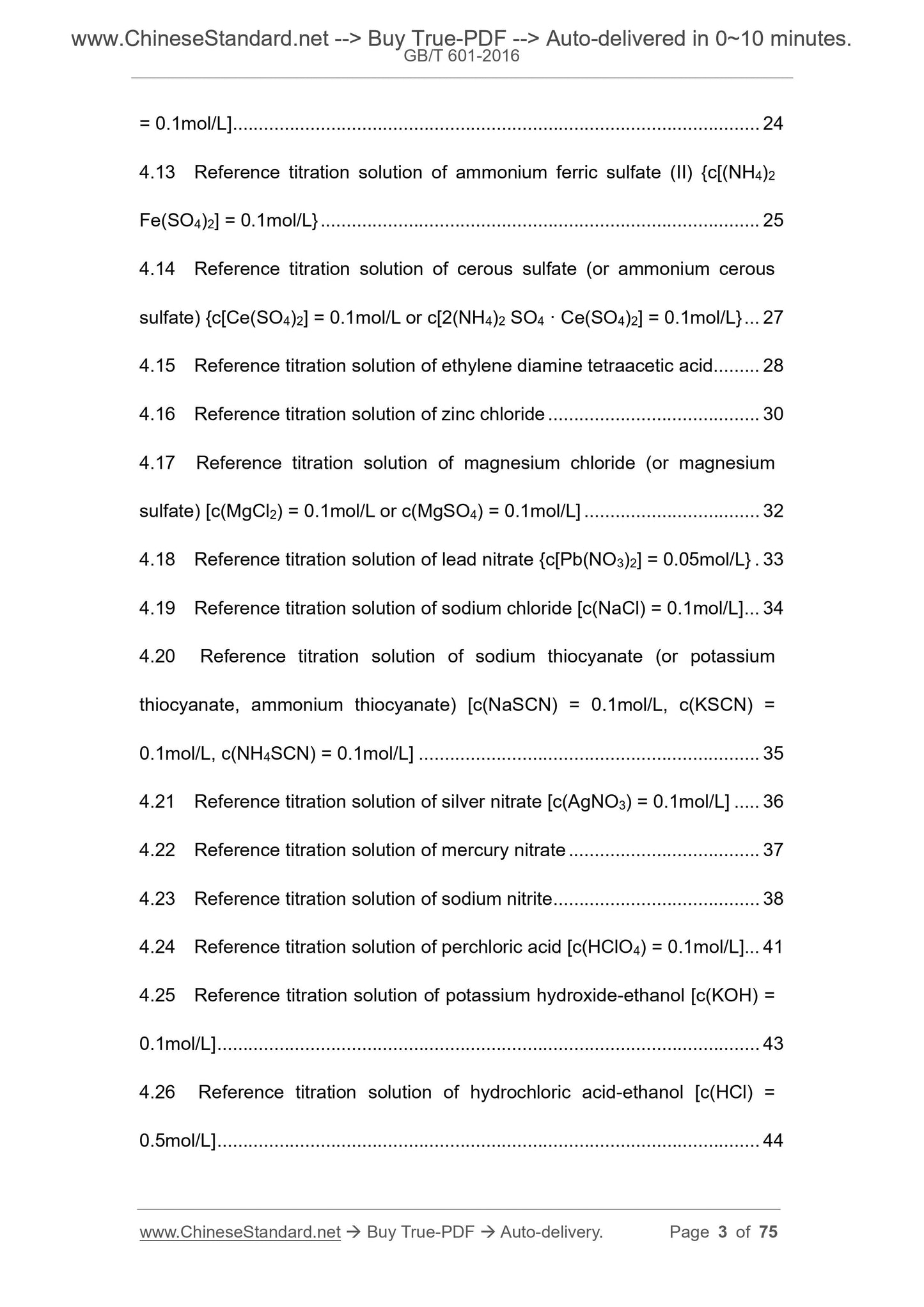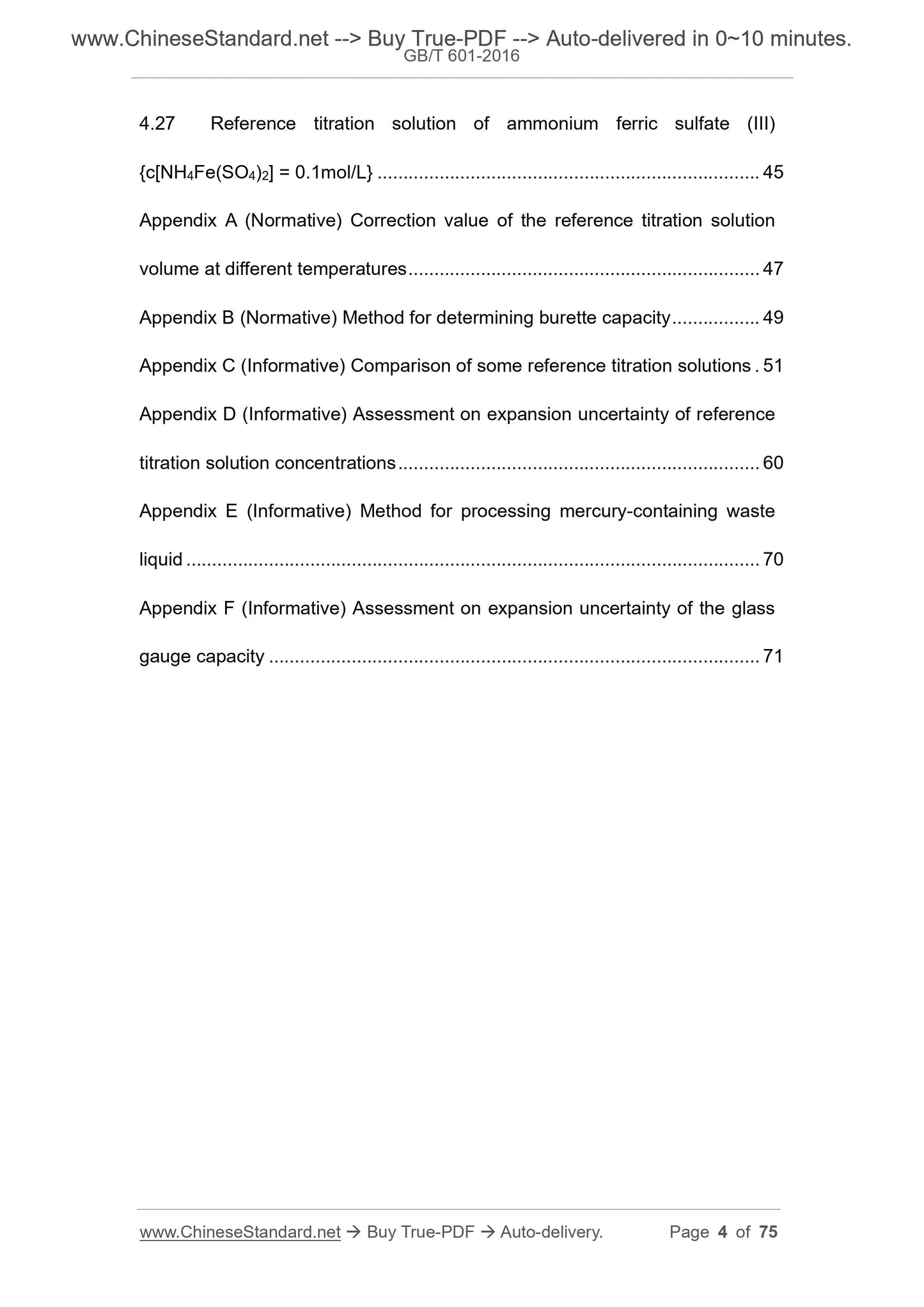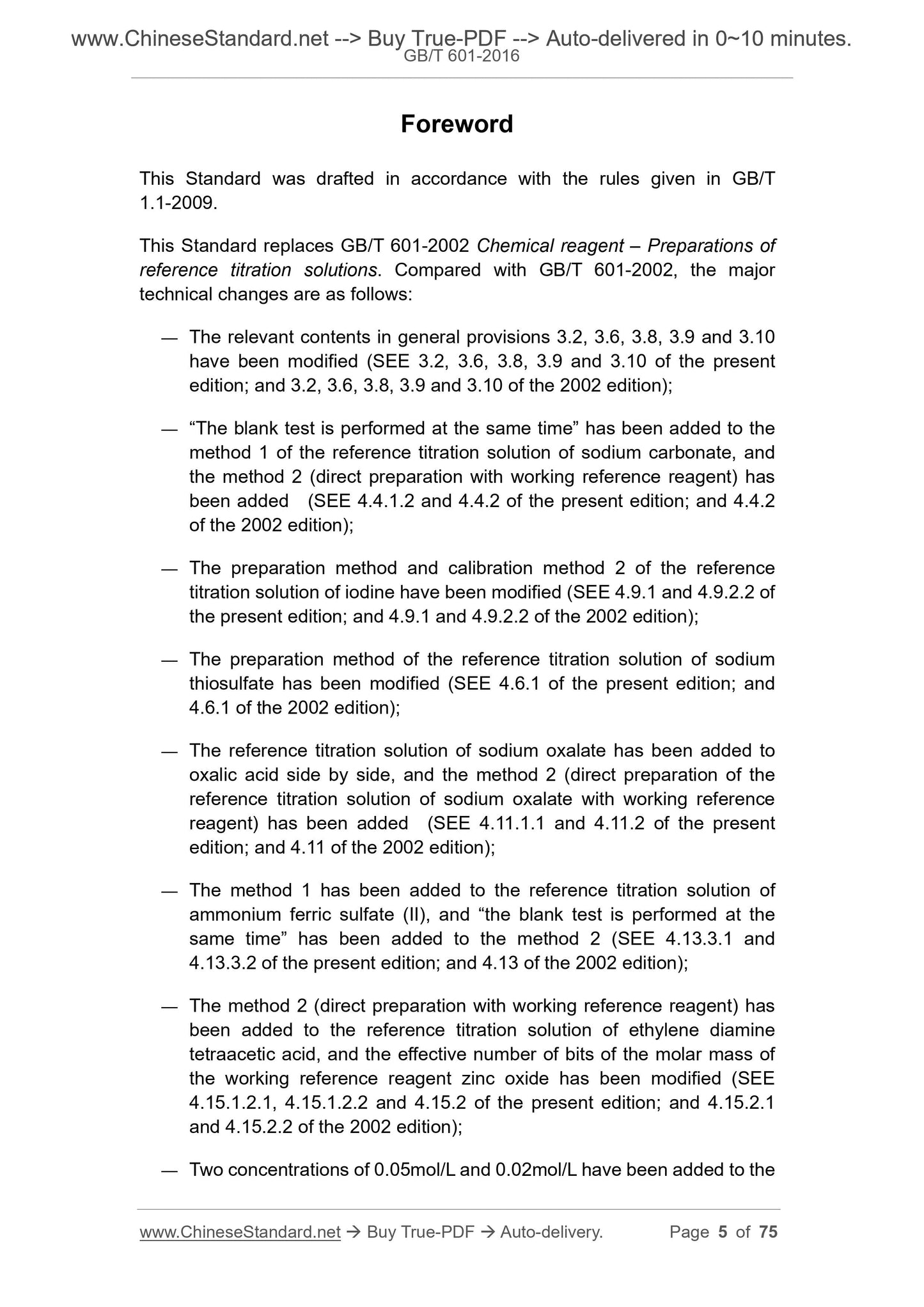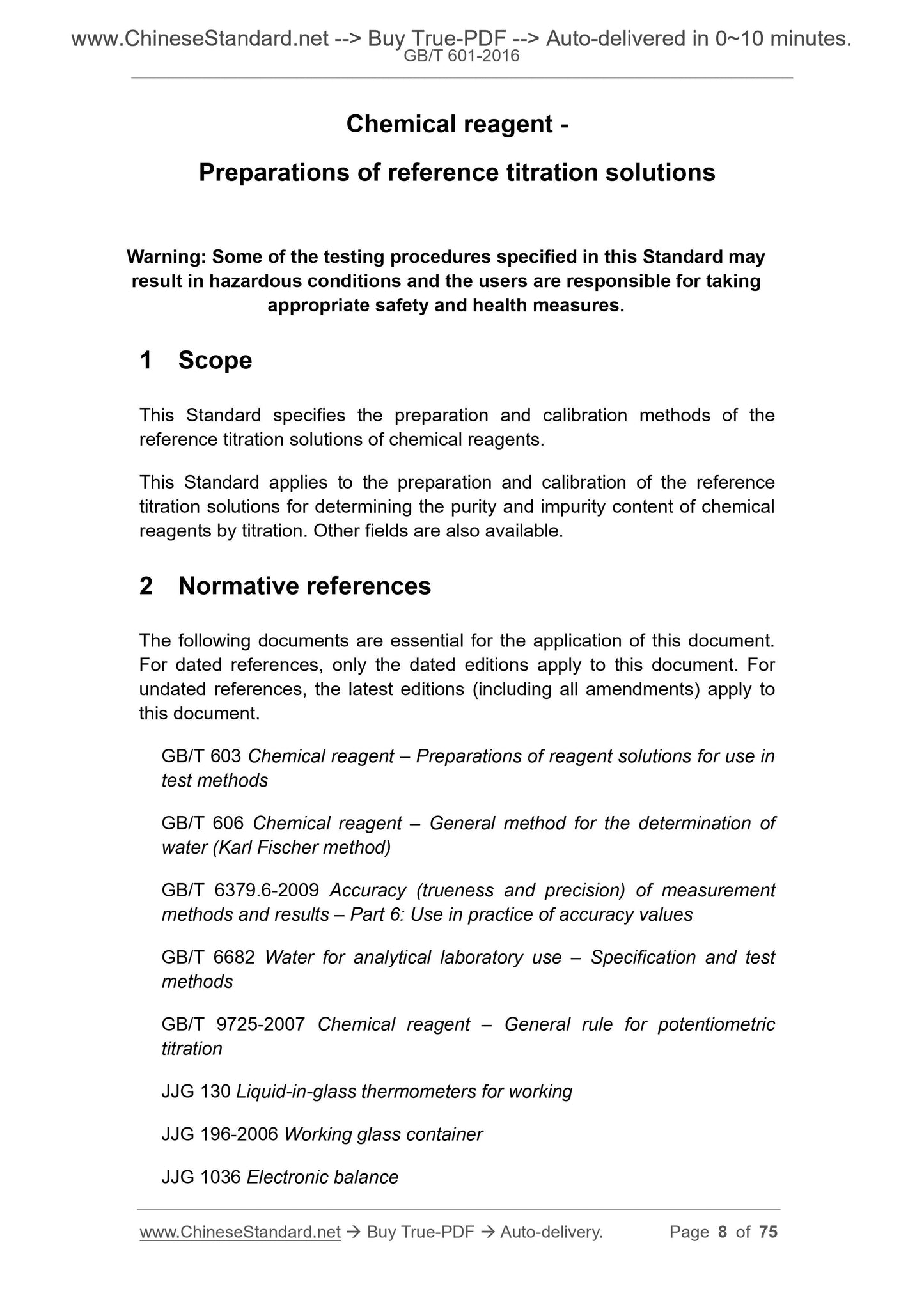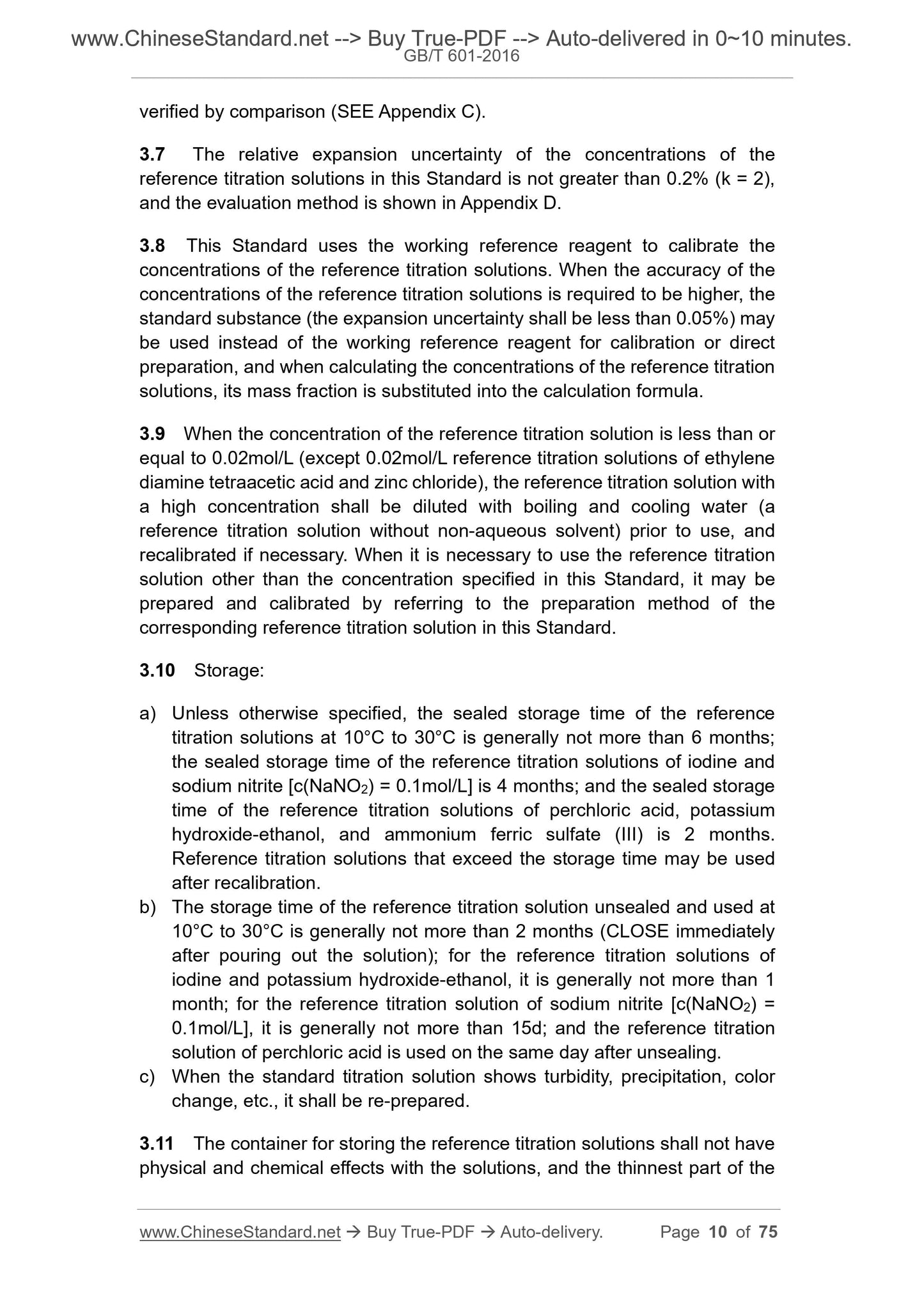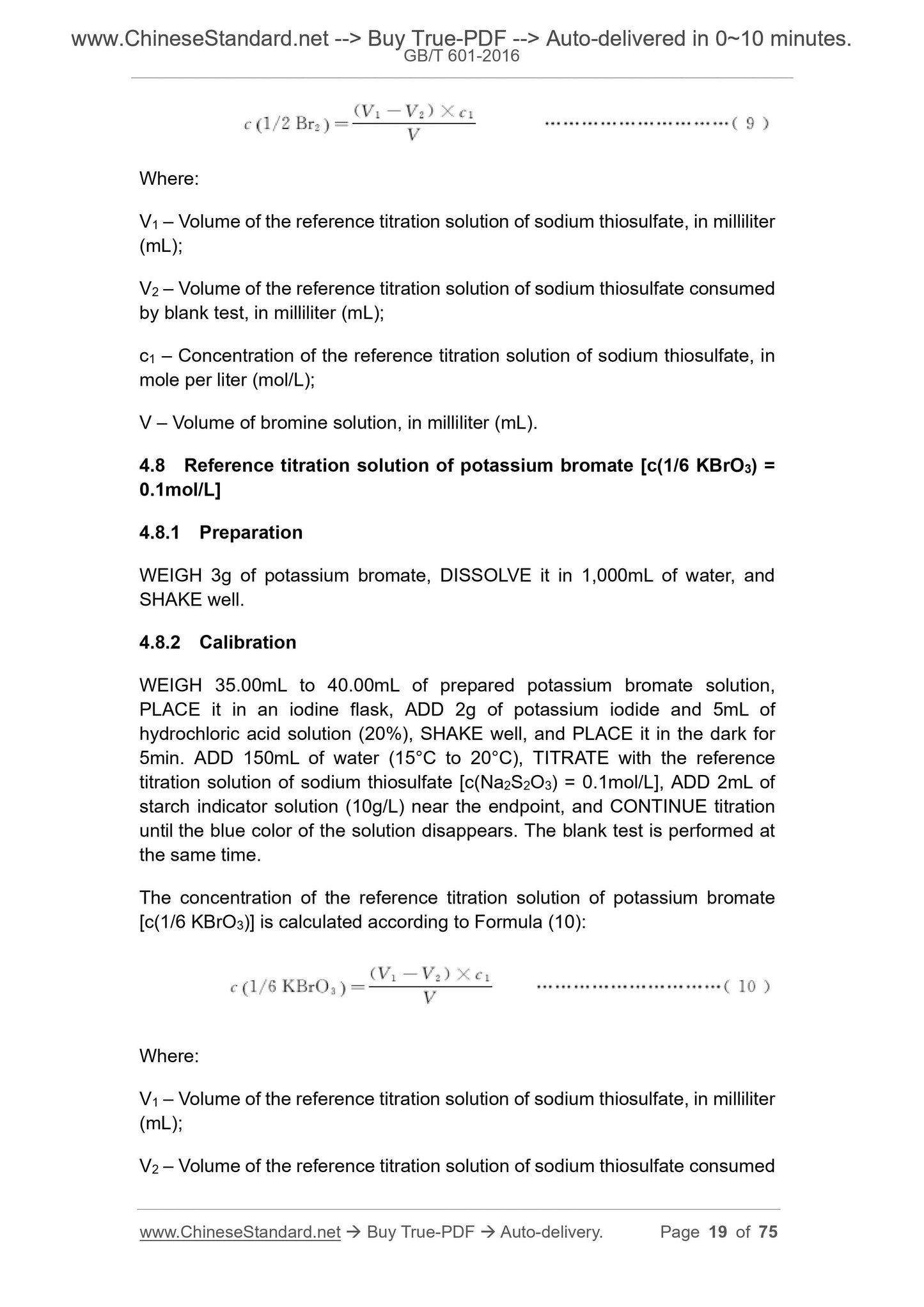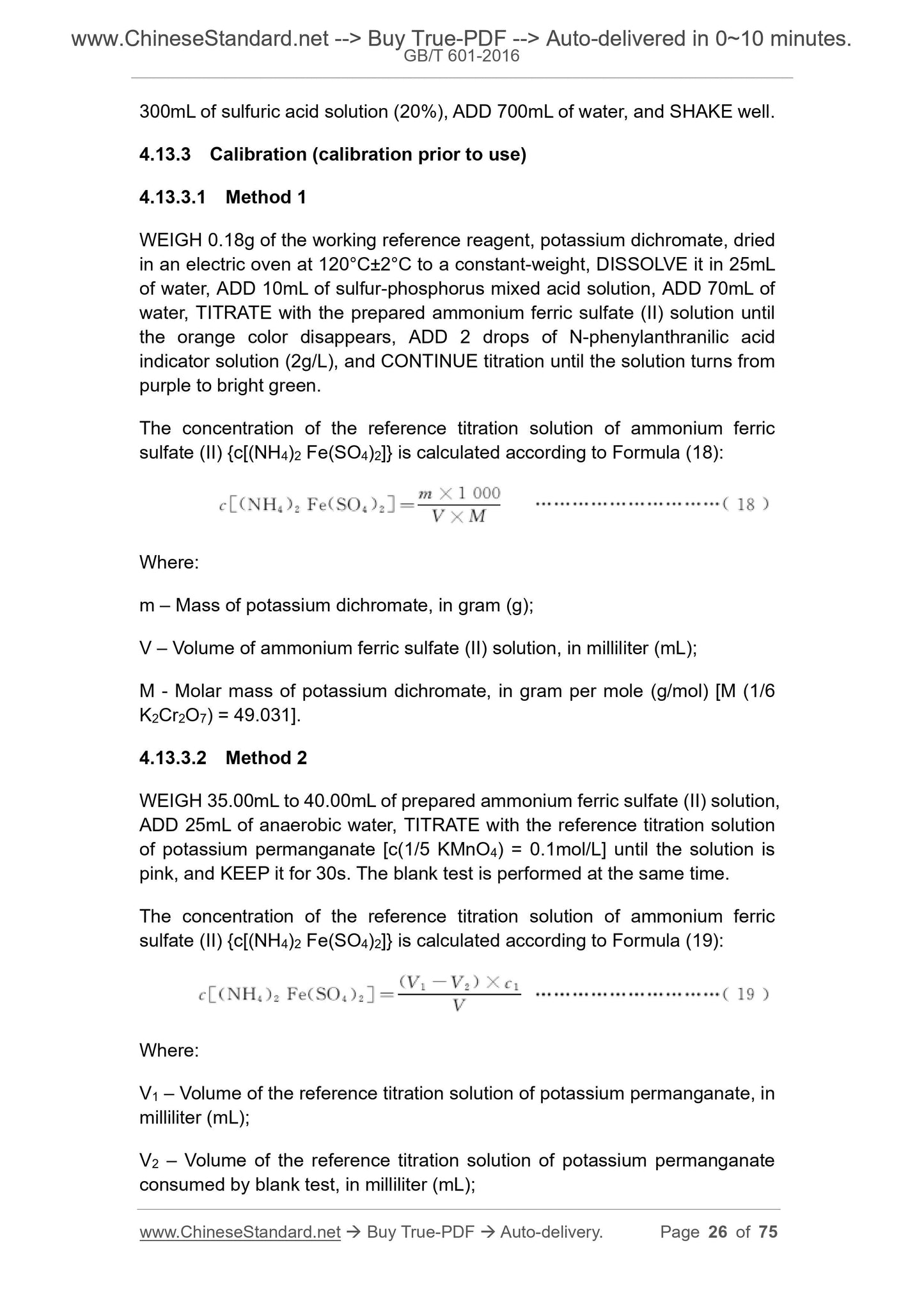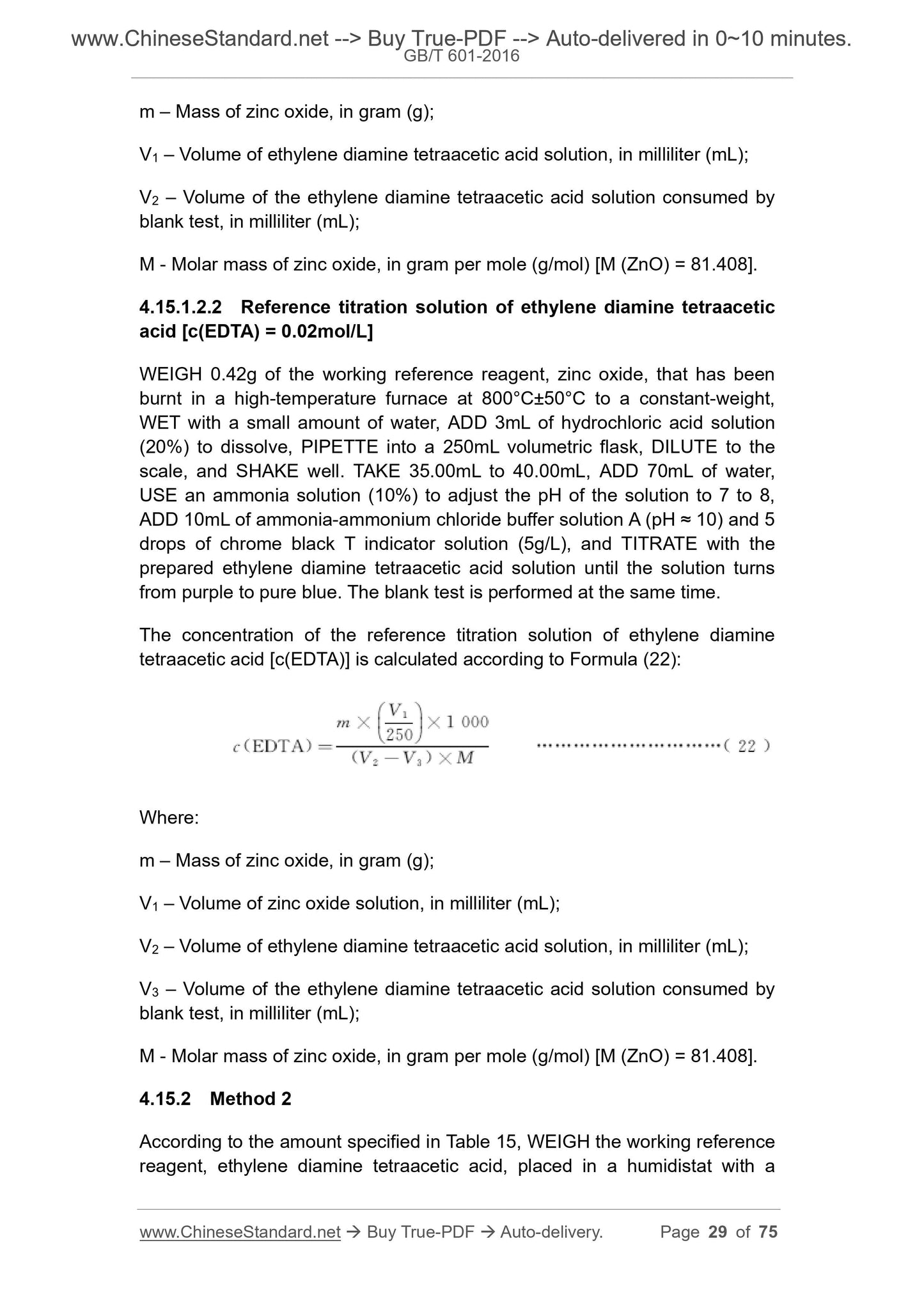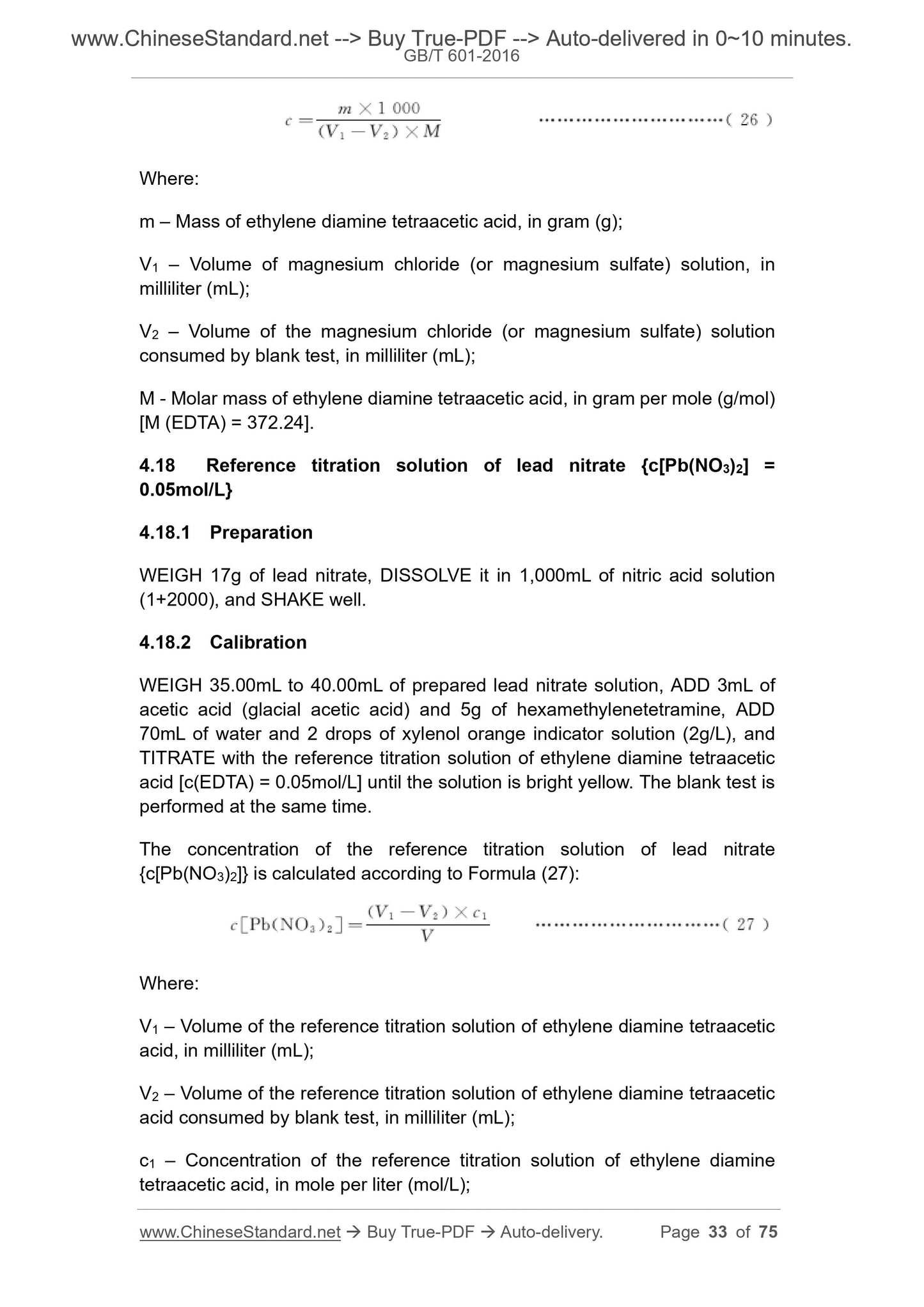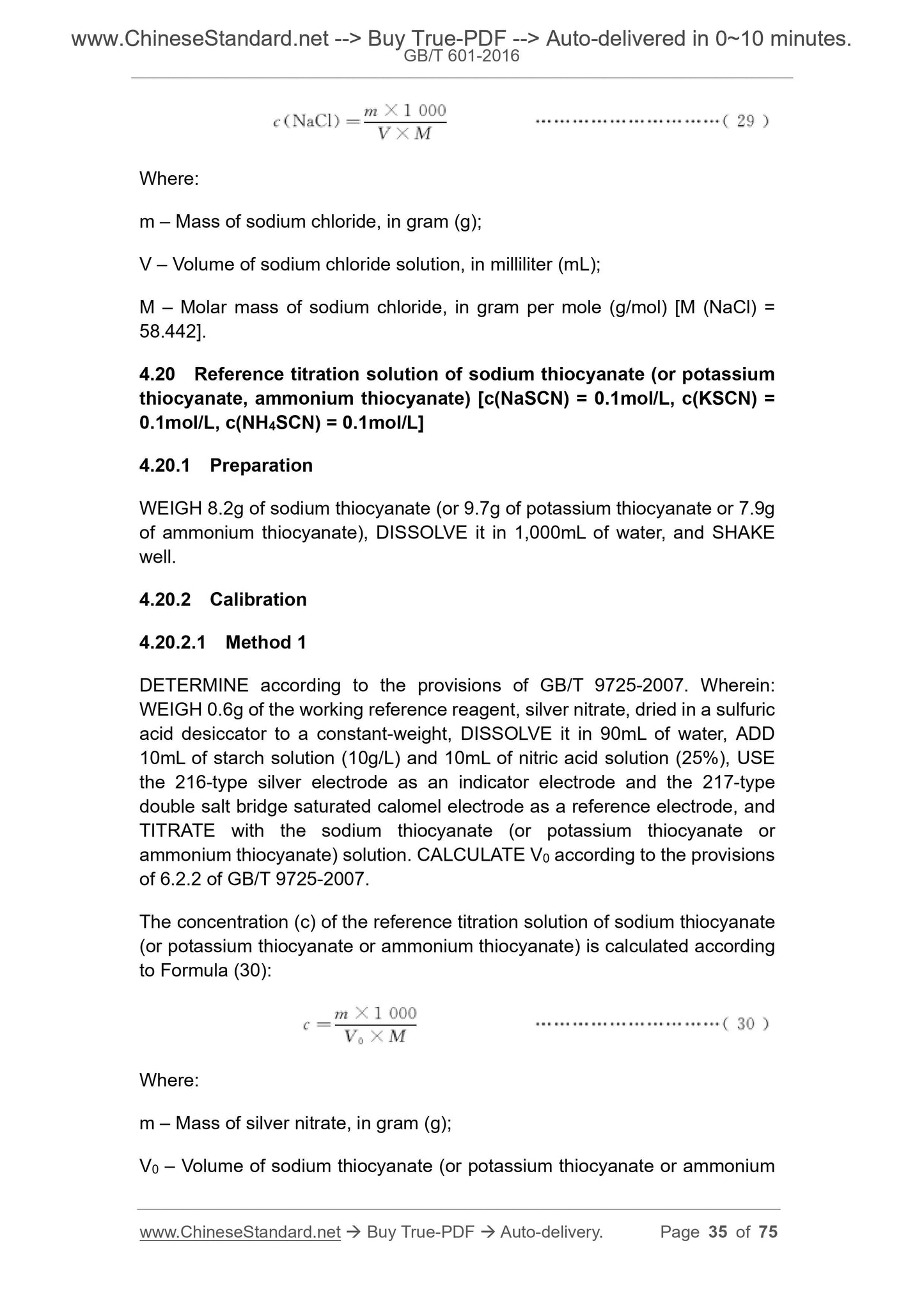1
/
of
12
www.ChineseStandard.us -- Field Test Asia Pte. Ltd.
GB/T 601-2016 English PDF (GB/T601-2016)
GB/T 601-2016 English PDF (GB/T601-2016)
Regular price
$285.00
Regular price
Sale price
$285.00
Unit price
/
per
Shipping calculated at checkout.
Couldn't load pickup availability
GB/T 601-2016: Chemical reagent - Preparations of reference titration solutions
Delivery: 9 seconds. Download (& Email) true-PDF + Invoice.
Get Quotation: Click GB/T 601-2016 (Self-service in 1-minute)
Historical versions (Master-website): GB/T 601-2016
Preview True-PDF (Reload/Scroll-down if blank)
GB/T 601-2016
NATIONAL STANDARD OF THE
PEOPLE’S REPUBLIC OF CHINA
ICS 71.040.40; 71.040.30
G 60
Replacing GB/T 601-2002
Chemical reagent -
Preparations of reference titration solutions
ISSUED ON: OCTOBER 13, 2016
IMPLEMENTED ON: MAY 1, 2017
Issued by: General Administration of Quality Supervision, Inspection
and Quarantine of the People’s Republic of China;
Standardization Administration of the People's Republic of
China.
Table of Contents
Foreword ... 5
1 Scope ... 8
2 Normative references ... 8
3 General rules ... 9
4 Preparation and calibration of reference titration solutions ... 11
4.1 Reference titration solution of sodium hydroxide ... 11
4.2 Reference titration solution of hydrochloric acid ... 12
4.3 Reference titration solution of sulfuric acid ... 13
4.4 Reference titration solution of sodium carbonate ... 14
4.5 Reference titration solution of potassium dichromate [c(1/6 K2Cr2O7) =
0.1mol/L] ... 16
4.6 Reference titration solution of sodium thiosulfate [c(Na2S2O3) = 0.1mol/L]
... 17
4.7 Reference titration solution of bromine [c(1/2 Br2) = 0.1mol/L] ... 18
4.8 Reference titration solution of potassium bromate [c(1/6 KBrO3) =
0.1mol/L] ... 19
4.9 Reference titration solution of iodine [c(1/2 I2) = 0.1mol/L] ... 20
4.10 Reference titration solution of potassium iodate ... 21
4.11 Reference titration solution of oxalic acid (or sodium oxalate) [c(1/2
H2C2O4) = 0.1mol/L or c(1/2 Na2C2O4) = 0.1mol/L] ... 23
4.12 Reference titration solution of potassium permanganate [c(1/5 KMnO4)
= 0.1mol/L] ... 24
4.13 Reference titration solution of ammonium ferric sulfate (II) {c[(NH4)2
Fe(SO4)2] = 0.1mol/L} ... 25
4.14 Reference titration solution of cerous sulfate (or ammonium cerous
sulfate) {c[Ce(SO4)2] = 0.1mol/L or c[2(NH4)2 SO4 · Ce(SO4)2] = 0.1mol/L} ... 27
4.15 Reference titration solution of ethylene diamine tetraacetic acid ... 28
4.16 Reference titration solution of zinc chloride ... 30
4.17 Reference titration solution of magnesium chloride (or magnesium
sulfate) [c(MgCl2) = 0.1mol/L or c(MgSO4) = 0.1mol/L] ... 32
4.18 Reference titration solution of lead nitrate {c[Pb(NO3)2] = 0.05mol/L} . 33
4.19 Reference titration solution of sodium chloride [c(NaCl) = 0.1mol/L] ... 34
4.20 Reference titration solution of sodium thiocyanate (or potassium
thiocyanate, ammonium thiocyanate) [c(NaSCN) = 0.1mol/L, c(KSCN) =
0.1mol/L, c(NH4SCN) = 0.1mol/L] ... 35
4.21 Reference titration solution of silver nitrate [c(AgNO3) = 0.1mol/L] ... 36
4.22 Reference titration solution of mercury nitrate ... 37
4.23 Reference titration solution of sodium nitrite ... 38
4.24 Reference titration solution of perchloric acid [c(HClO4) = 0.1mol/L] ... 41
4.25 Reference titration solution of potassium hydroxide-ethanol [c(KOH) =
0.1mol/L] ... 43
4.26 Reference titration solution of hydrochloric acid-ethanol [c(HCl) =
0.5mol/L] ... 44
4.27 Reference titration solution of ammonium ferric sulfate (III)
{c[NH4Fe(SO4)2] = 0.1mol/L} ... 45
Appendix A (Normative) Correction value of the reference titration solution
volume at different temperatures ... 47
Appendix B (Normative) Method for determining burette capacity ... 49
Appendix C (Informative) Comparison of some reference titration solutions . 51
Appendix D (Informative) Assessment on expansion uncertainty of reference
titration solution concentrations ... 60
Appendix E (Informative) Method for processing mercury-containing waste
liquid ... 70
Appendix F (Informative) Assessment on expansion uncertainty of the glass
gauge capacity ... 71
Foreword
This Standard was drafted in accordance with the rules given in GB/T
1.1-2009.
This Standard replaces GB/T 601-2002 Chemical reagent – Preparations of
reference titration solutions. Compared with GB/T 601-2002, the major
technical changes are as follows:
— The relevant contents in general provisions 3.2, 3.6, 3.8, 3.9 and 3.10
have been modified (SEE 3.2, 3.6, 3.8, 3.9 and 3.10 of the present
edition; and 3.2, 3.6, 3.8, 3.9 and 3.10 of the 2002 edition);
— “The blank test is performed at the same time” has been added to the
method 1 of the reference titration solution of sodium carbonate, and
the method 2 (direct preparation with working reference reagent) has
been added (SEE 4.4.1.2 and 4.4.2 of the present edition; and 4.4.2
of the 2002 edition);
— The preparation method and calibration method 2 of the reference
titration solution of iodine have been modified (SEE 4.9.1 and 4.9.2.2 of
the present edition; and 4.9.1 and 4.9.2.2 of the 2002 edition);
— The preparation method of the reference titration solution of sodium
thiosulfate has been modified (SEE 4.6.1 of the present edition; and
4.6.1 of the 2002 edition);
— The reference titration solution of sodium oxalate has been added to
oxalic acid side by side, and the method 2 (direct preparation of the
reference titration solution of sodium oxalate with working reference
reagent) has been added (SEE 4.11.1.1 and 4.11.2 of the present
edition; and 4.11 of the 2002 edition);
— The method 1 has been added to the reference titration solution of
ammonium ferric sulfate (II), and “the blank test is performed at the
same time” has been added to the method 2 (SEE 4.13.3.1 and
4.13.3.2 of the present edition; and 4.13 of the 2002 edition);
— The method 2 (direct preparation with working reference reagent) has
been added to the reference titration solution of ethylene diamine
tetraacetic acid, and the effective number of bits of the molar mass of
the working reference reagent zinc oxide has been modified (SEE
4.15.1.2.1, 4.15.1.2.2 and 4.15.2 of the present edition; and 4.15.2.1
and 4.15.2.2 of the 2002 edition);
— Two concentrations of 0.05mol/L and 0.02mol/L have been added to the
Chemical reagent -
Preparations of reference titration solutions
Warning: Some of the testing procedures specified in this Standard may
result in hazardous conditions and the users are responsible for taking
appropriate safety and health measures.
1 Scope
This Standard specifies the preparation and calibration methods of the
reference titration solutions of chemical reagents.
This Standard applies to the preparation and calibration of the reference
titration solutions for determining the purity and impurity content of chemical
reagents by titration. Other fields are also available.
2 Normative references
The following documents are essential for the application of this document.
For dated references, only the dated editions apply to this document. For
undated references, the latest editions (including all amendments) apply to
this document.
GB/T 603 Chemical reagent – Preparations of reagent solutions for use in
test methods
GB/T 606 Chemical reagent – General method for the determination of
water (Karl Fischer method)
GB/T 6379.6-2009 Accuracy (trueness and precision) of measurement
methods and results – Part 6: Use in practice of accuracy values
GB/T 6682 Water for analytical laboratory use – Specification and test
methods
GB/T 9725-2007 Chemical reagent – General rule for potentiometric
titration
JJG 130 Liquid-in-glass thermometers for working
JJG 196-2006 Working glass container
JJG 1036 Electronic balance
verified by comparison (SEE Appendix C).
3.7 The relative expansion uncertainty of the concentrations of the
reference titration solutions in this Standard is not greater than 0.2% (k = 2),
and the evaluation method is shown in Appendix D.
3.8 This Standard uses the working reference reagent to calibrate the
concentrations of the reference titration solutions. When the accuracy of the
concentrations of the reference titration solutions is required to be higher, the
standard substance (the expansion uncertainty shall be less than 0.05%) may
be used instead of the working reference reagent for calibration or direct
preparation, and when calculating the concentrations of the reference titration
solutions, its mass fraction is substituted into the calculation formula.
3.9 When the concentration of the reference titration solution is less than or
equal to 0.02mol/L (except 0.02mol/L reference titration solutions of ethylene
diamine tetraacetic acid and zinc chloride), the reference titration solution with
a high concentration shall be diluted with boiling and cooling water (a
reference titration solution without non-aqueous solvent) prior to use, and
recalibrated if necessary. When it is necessary to use the reference titration
solution other than the concentration specified in this Standard, it may be
prepared and calibrated by referring to the preparation method of the
corresponding reference titration solution in this Standard.
3.10 Storage:
a) Unless otherwise specified, the sealed storage time of the reference
titration solutions at 10°C to 30°C is generally not more than 6 months;
the sealed storage time of the reference titration solutions of iodine and
sodium nitrite [c(NaNO2) = 0.1mol/L] is 4 months; and the sealed storage
time of the reference titration solutions of perchloric acid, potassium
hydroxide-ethanol, and ammonium ferric sulfate (III) is 2 months.
Reference titration solutions that exceed the storage time may be used
after recalibration.
b) The storage time of the reference titration solution unsealed and used at
10°C to 30°C is generally not more than 2 months (CLOSE immediately
after pouring out the solution); for the reference titration solutions of
iodine and potassium hydroxide-ethanol, it is generally not more than 1
month; for the reference titration solution of sodium nitrite [c(NaNO2) =
0.1mol/L], it is generally not more than 15d; and the reference titration
solution of perchloric acid is used on the same day after unsealing.
c) When the standard titration solution shows turbidity, precipitation, color
change, etc., it shall be re-prepared.
3.11 The container for storing the reference titration solutions shall not have
physical and chemical effects with the solutions, and the thinnest part of the
Where:
V1 – Volume of the reference titration solution of sodium thiosulfate, in milliliter
(mL);
V2 – Volume of the reference titration solution of sodium thiosulfate consumed
by blank test, in milliliter (mL);
c1 – Concentration of the reference titration solution of sodium thiosulfate, in
mole per liter (mol/L);
V – Volume of bromine solution, in milliliter (mL).
4.8 Reference titration solution of potassium bromate [c(1/6 KBrO3) =
0.1mol/L]
4.8.1 Preparation
WEIGH 3g of potassium bromate, DISSOLVE it in 1,000mL of water, and
SHAKE well.
4.8.2 Calibration
WEIGH 35.00mL to 40.00mL of prepared potassium bromate solution,
PLACE it in an iodine flask, ADD 2g of potassium iodide and 5mL of
hydrochloric acid solution (20%), SHAKE well, and PLACE it in the dark for
5min. ADD 150mL of water (15°C to 20°C), TITRATE with the reference
titration solution of sodium thiosulfate [c(Na2S2O3) = 0.1mol/L], ADD 2mL of
starch indicator solution (10g/L) near the endpoint, and CONTINUE titration
until the blue color of the solution disappears. The blank test is performed at
the same time.
The concentration of the reference titration solution of potassium bromate
[c(1/6 KBrO3)] is calculated according to Formula (10):
Where:
V1 – Volume of the reference titration solution of sodium thiosulfate, in milliliter
(mL);
V2 – Volume of the reference titration solution of sodium thiosulfate consumed
300mL of sulfuric acid solution (20%), ADD 700mL of water, and SHAKE well.
4.13.3 Calibration (calibration prior to use)
4.13.3.1 Method 1
WEIGH 0.18g of the working reference reagent, potassium dichromate, dried
in an electric oven at 120°C±2°C to a constant-weight, DISSOLVE it in 25mL
of water, ADD 10mL of sulfur-phosphorus mixed acid solution, ADD 70mL of
water, TITRATE with the prepared ammonium ferric sulfate (II) solution until
the orange color disappears, ADD 2 drops of N-phenylanthranilic acid
indicator solution (2g/L), and CONTINUE titration until the solution turns from
purple to bright green.
The concentration of the reference titration solution of ammonium ferric
sulfate (II) {c[(NH4)2 Fe(SO4)2]} is calculated according to Formula (18):
Where:
m – Mass of potassium dichromate, in gram (g);
V – Volume of ammonium ferric sulfate (II) solution, in milliliter (mL);
M - Molar mass of potassium dichromate, in gram per mole (g/mol) [M (1/6
K2Cr2O7) = 49.031].
4.13.3.2 Method 2
WEIGH 35.00mL to 40.00mL of prepared ammonium ferric sulfate (II) solution,
ADD 25mL of anaerobic water, TITRATE with the reference titration solution
of potassium permanganate [c(1/5 KMnO4) = 0.1mol/L] until the solution is
pink, and KEEP it for 30s. The blank test is performed at the same time.
The concentration of the reference titration solution of ammonium ferric
sulfate (II) {c[(NH4)2 Fe(SO4)2]} is calculated according to Formula (19):
Where:
V1 – Volume of the reference titration solution of potassium permanganate, in
milliliter (mL);
V2 – Volume of the reference titration solution of potassium permanganate
consumed by blank test, in milliliter (mL);
m – Mass of zinc oxide, in gram (g);
V1 – Volume of ethylene diamine tetraacetic acid solution, in milliliter (mL);
V2 – Volume of the ethylene diamine tetraacetic acid solution consumed by
blank test, in milliliter (mL);
M - Molar mass of zinc oxide, in gram per mole (g/mol) [M (ZnO) = 81.408].
4.15.1.2.2 Reference titration solution of ethylene diamine tetraacetic
acid [c(EDTA) = 0.02mol/L]
WEIGH 0.42g of the working reference reagent, zinc oxide, that has been
burnt in a high-temperature furnace at 800°C±50°C to a constant-weight,
WET with a small amount of water, ADD 3mL of hydrochloric acid solution
(20%) to dissolve, PIPETTE into a 250mL volumetric flask, DILUTE to the
scale, and SHAKE well. TAKE 35.00mL to 40.00mL, ADD 70mL of water,
USE an ammonia solution (10%) to ...
Delivery: 9 seconds. Download (& Email) true-PDF + Invoice.
Get Quotation: Click GB/T 601-2016 (Self-service in 1-minute)
Historical versions (Master-website): GB/T 601-2016
Preview True-PDF (Reload/Scroll-down if blank)
GB/T 601-2016
NATIONAL STANDARD OF THE
PEOPLE’S REPUBLIC OF CHINA
ICS 71.040.40; 71.040.30
G 60
Replacing GB/T 601-2002
Chemical reagent -
Preparations of reference titration solutions
ISSUED ON: OCTOBER 13, 2016
IMPLEMENTED ON: MAY 1, 2017
Issued by: General Administration of Quality Supervision, Inspection
and Quarantine of the People’s Republic of China;
Standardization Administration of the People's Republic of
China.
Table of Contents
Foreword ... 5
1 Scope ... 8
2 Normative references ... 8
3 General rules ... 9
4 Preparation and calibration of reference titration solutions ... 11
4.1 Reference titration solution of sodium hydroxide ... 11
4.2 Reference titration solution of hydrochloric acid ... 12
4.3 Reference titration solution of sulfuric acid ... 13
4.4 Reference titration solution of sodium carbonate ... 14
4.5 Reference titration solution of potassium dichromate [c(1/6 K2Cr2O7) =
0.1mol/L] ... 16
4.6 Reference titration solution of sodium thiosulfate [c(Na2S2O3) = 0.1mol/L]
... 17
4.7 Reference titration solution of bromine [c(1/2 Br2) = 0.1mol/L] ... 18
4.8 Reference titration solution of potassium bromate [c(1/6 KBrO3) =
0.1mol/L] ... 19
4.9 Reference titration solution of iodine [c(1/2 I2) = 0.1mol/L] ... 20
4.10 Reference titration solution of potassium iodate ... 21
4.11 Reference titration solution of oxalic acid (or sodium oxalate) [c(1/2
H2C2O4) = 0.1mol/L or c(1/2 Na2C2O4) = 0.1mol/L] ... 23
4.12 Reference titration solution of potassium permanganate [c(1/5 KMnO4)
= 0.1mol/L] ... 24
4.13 Reference titration solution of ammonium ferric sulfate (II) {c[(NH4)2
Fe(SO4)2] = 0.1mol/L} ... 25
4.14 Reference titration solution of cerous sulfate (or ammonium cerous
sulfate) {c[Ce(SO4)2] = 0.1mol/L or c[2(NH4)2 SO4 · Ce(SO4)2] = 0.1mol/L} ... 27
4.15 Reference titration solution of ethylene diamine tetraacetic acid ... 28
4.16 Reference titration solution of zinc chloride ... 30
4.17 Reference titration solution of magnesium chloride (or magnesium
sulfate) [c(MgCl2) = 0.1mol/L or c(MgSO4) = 0.1mol/L] ... 32
4.18 Reference titration solution of lead nitrate {c[Pb(NO3)2] = 0.05mol/L} . 33
4.19 Reference titration solution of sodium chloride [c(NaCl) = 0.1mol/L] ... 34
4.20 Reference titration solution of sodium thiocyanate (or potassium
thiocyanate, ammonium thiocyanate) [c(NaSCN) = 0.1mol/L, c(KSCN) =
0.1mol/L, c(NH4SCN) = 0.1mol/L] ... 35
4.21 Reference titration solution of silver nitrate [c(AgNO3) = 0.1mol/L] ... 36
4.22 Reference titration solution of mercury nitrate ... 37
4.23 Reference titration solution of sodium nitrite ... 38
4.24 Reference titration solution of perchloric acid [c(HClO4) = 0.1mol/L] ... 41
4.25 Reference titration solution of potassium hydroxide-ethanol [c(KOH) =
0.1mol/L] ... 43
4.26 Reference titration solution of hydrochloric acid-ethanol [c(HCl) =
0.5mol/L] ... 44
4.27 Reference titration solution of ammonium ferric sulfate (III)
{c[NH4Fe(SO4)2] = 0.1mol/L} ... 45
Appendix A (Normative) Correction value of the reference titration solution
volume at different temperatures ... 47
Appendix B (Normative) Method for determining burette capacity ... 49
Appendix C (Informative) Comparison of some reference titration solutions . 51
Appendix D (Informative) Assessment on expansion uncertainty of reference
titration solution concentrations ... 60
Appendix E (Informative) Method for processing mercury-containing waste
liquid ... 70
Appendix F (Informative) Assessment on expansion uncertainty of the glass
gauge capacity ... 71
Foreword
This Standard was drafted in accordance with the rules given in GB/T
1.1-2009.
This Standard replaces GB/T 601-2002 Chemical reagent – Preparations of
reference titration solutions. Compared with GB/T 601-2002, the major
technical changes are as follows:
— The relevant contents in general provisions 3.2, 3.6, 3.8, 3.9 and 3.10
have been modified (SEE 3.2, 3.6, 3.8, 3.9 and 3.10 of the present
edition; and 3.2, 3.6, 3.8, 3.9 and 3.10 of the 2002 edition);
— “The blank test is performed at the same time” has been added to the
method 1 of the reference titration solution of sodium carbonate, and
the method 2 (direct preparation with working reference reagent) has
been added (SEE 4.4.1.2 and 4.4.2 of the present edition; and 4.4.2
of the 2002 edition);
— The preparation method and calibration method 2 of the reference
titration solution of iodine have been modified (SEE 4.9.1 and 4.9.2.2 of
the present edition; and 4.9.1 and 4.9.2.2 of the 2002 edition);
— The preparation method of the reference titration solution of sodium
thiosulfate has been modified (SEE 4.6.1 of the present edition; and
4.6.1 of the 2002 edition);
— The reference titration solution of sodium oxalate has been added to
oxalic acid side by side, and the method 2 (direct preparation of the
reference titration solution of sodium oxalate with working reference
reagent) has been added (SEE 4.11.1.1 and 4.11.2 of the present
edition; and 4.11 of the 2002 edition);
— The method 1 has been added to the reference titration solution of
ammonium ferric sulfate (II), and “the blank test is performed at the
same time” has been added to the method 2 (SEE 4.13.3.1 and
4.13.3.2 of the present edition; and 4.13 of the 2002 edition);
— The method 2 (direct preparation with working reference reagent) has
been added to the reference titration solution of ethylene diamine
tetraacetic acid, and the effective number of bits of the molar mass of
the working reference reagent zinc oxide has been modified (SEE
4.15.1.2.1, 4.15.1.2.2 and 4.15.2 of the present edition; and 4.15.2.1
and 4.15.2.2 of the 2002 edition);
— Two concentrations of 0.05mol/L and 0.02mol/L have been added to the
Chemical reagent -
Preparations of reference titration solutions
Warning: Some of the testing procedures specified in this Standard may
result in hazardous conditions and the users are responsible for taking
appropriate safety and health measures.
1 Scope
This Standard specifies the preparation and calibration methods of the
reference titration solutions of chemical reagents.
This Standard applies to the preparation and calibration of the reference
titration solutions for determining the purity and impurity content of chemical
reagents by titration. Other fields are also available.
2 Normative references
The following documents are essential for the application of this document.
For dated references, only the dated editions apply to this document. For
undated references, the latest editions (including all amendments) apply to
this document.
GB/T 603 Chemical reagent – Preparations of reagent solutions for use in
test methods
GB/T 606 Chemical reagent – General method for the determination of
water (Karl Fischer method)
GB/T 6379.6-2009 Accuracy (trueness and precision) of measurement
methods and results – Part 6: Use in practice of accuracy values
GB/T 6682 Water for analytical laboratory use – Specification and test
methods
GB/T 9725-2007 Chemical reagent – General rule for potentiometric
titration
JJG 130 Liquid-in-glass thermometers for working
JJG 196-2006 Working glass container
JJG 1036 Electronic balance
verified by comparison (SEE Appendix C).
3.7 The relative expansion uncertainty of the concentrations of the
reference titration solutions in this Standard is not greater than 0.2% (k = 2),
and the evaluation method is shown in Appendix D.
3.8 This Standard uses the working reference reagent to calibrate the
concentrations of the reference titration solutions. When the accuracy of the
concentrations of the reference titration solutions is required to be higher, the
standard substance (the expansion uncertainty shall be less than 0.05%) may
be used instead of the working reference reagent for calibration or direct
preparation, and when calculating the concentrations of the reference titration
solutions, its mass fraction is substituted into the calculation formula.
3.9 When the concentration of the reference titration solution is less than or
equal to 0.02mol/L (except 0.02mol/L reference titration solutions of ethylene
diamine tetraacetic acid and zinc chloride), the reference titration solution with
a high concentration shall be diluted with boiling and cooling water (a
reference titration solution without non-aqueous solvent) prior to use, and
recalibrated if necessary. When it is necessary to use the reference titration
solution other than the concentration specified in this Standard, it may be
prepared and calibrated by referring to the preparation method of the
corresponding reference titration solution in this Standard.
3.10 Storage:
a) Unless otherwise specified, the sealed storage time of the reference
titration solutions at 10°C to 30°C is generally not more than 6 months;
the sealed storage time of the reference titration solutions of iodine and
sodium nitrite [c(NaNO2) = 0.1mol/L] is 4 months; and the sealed storage
time of the reference titration solutions of perchloric acid, potassium
hydroxide-ethanol, and ammonium ferric sulfate (III) is 2 months.
Reference titration solutions that exceed the storage time may be used
after recalibration.
b) The storage time of the reference titration solution unsealed and used at
10°C to 30°C is generally not more than 2 months (CLOSE immediately
after pouring out the solution); for the reference titration solutions of
iodine and potassium hydroxide-ethanol, it is generally not more than 1
month; for the reference titration solution of sodium nitrite [c(NaNO2) =
0.1mol/L], it is generally not more than 15d; and the reference titration
solution of perchloric acid is used on the same day after unsealing.
c) When the standard titration solution shows turbidity, precipitation, color
change, etc., it shall be re-prepared.
3.11 The container for storing the reference titration solutions shall not have
physical and chemical effects with the solutions, and the thinnest part of the
Where:
V1 – Volume of the reference titration solution of sodium thiosulfate, in milliliter
(mL);
V2 – Volume of the reference titration solution of sodium thiosulfate consumed
by blank test, in milliliter (mL);
c1 – Concentration of the reference titration solution of sodium thiosulfate, in
mole per liter (mol/L);
V – Volume of bromine solution, in milliliter (mL).
4.8 Reference titration solution of potassium bromate [c(1/6 KBrO3) =
0.1mol/L]
4.8.1 Preparation
WEIGH 3g of potassium bromate, DISSOLVE it in 1,000mL of water, and
SHAKE well.
4.8.2 Calibration
WEIGH 35.00mL to 40.00mL of prepared potassium bromate solution,
PLACE it in an iodine flask, ADD 2g of potassium iodide and 5mL of
hydrochloric acid solution (20%), SHAKE well, and PLACE it in the dark for
5min. ADD 150mL of water (15°C to 20°C), TITRATE with the reference
titration solution of sodium thiosulfate [c(Na2S2O3) = 0.1mol/L], ADD 2mL of
starch indicator solution (10g/L) near the endpoint, and CONTINUE titration
until the blue color of the solution disappears. The blank test is performed at
the same time.
The concentration of the reference titration solution of potassium bromate
[c(1/6 KBrO3)] is calculated according to Formula (10):
Where:
V1 – Volume of the reference titration solution of sodium thiosulfate, in milliliter
(mL);
V2 – Volume of the reference titration solution of sodium thiosulfate consumed
300mL of sulfuric acid solution (20%), ADD 700mL of water, and SHAKE well.
4.13.3 Calibration (calibration prior to use)
4.13.3.1 Method 1
WEIGH 0.18g of the working reference reagent, potassium dichromate, dried
in an electric oven at 120°C±2°C to a constant-weight, DISSOLVE it in 25mL
of water, ADD 10mL of sulfur-phosphorus mixed acid solution, ADD 70mL of
water, TITRATE with the prepared ammonium ferric sulfate (II) solution until
the orange color disappears, ADD 2 drops of N-phenylanthranilic acid
indicator solution (2g/L), and CONTINUE titration until the solution turns from
purple to bright green.
The concentration of the reference titration solution of ammonium ferric
sulfate (II) {c[(NH4)2 Fe(SO4)2]} is calculated according to Formula (18):
Where:
m – Mass of potassium dichromate, in gram (g);
V – Volume of ammonium ferric sulfate (II) solution, in milliliter (mL);
M - Molar mass of potassium dichromate, in gram per mole (g/mol) [M (1/6
K2Cr2O7) = 49.031].
4.13.3.2 Method 2
WEIGH 35.00mL to 40.00mL of prepared ammonium ferric sulfate (II) solution,
ADD 25mL of anaerobic water, TITRATE with the reference titration solution
of potassium permanganate [c(1/5 KMnO4) = 0.1mol/L] until the solution is
pink, and KEEP it for 30s. The blank test is performed at the same time.
The concentration of the reference titration solution of ammonium ferric
sulfate (II) {c[(NH4)2 Fe(SO4)2]} is calculated according to Formula (19):
Where:
V1 – Volume of the reference titration solution of potassium permanganate, in
milliliter (mL);
V2 – Volume of the reference titration solution of potassium permanganate
consumed by blank test, in milliliter (mL);
m – Mass of zinc oxide, in gram (g);
V1 – Volume of ethylene diamine tetraacetic acid solution, in milliliter (mL);
V2 – Volume of the ethylene diamine tetraacetic acid solution consumed by
blank test, in milliliter (mL);
M - Molar mass of zinc oxide, in gram per mole (g/mol) [M (ZnO) = 81.408].
4.15.1.2.2 Reference titration solution of ethylene diamine tetraacetic
acid [c(EDTA) = 0.02mol/L]
WEIGH 0.42g of the working reference reagent, zinc oxide, that has been
burnt in a high-temperature furnace at 800°C±50°C to a constant-weight,
WET with a small amount of water, ADD 3mL of hydrochloric acid solution
(20%) to dissolve, PIPETTE into a 250mL volumetric flask, DILUTE to the
scale, and SHAKE well. TAKE 35.00mL to 40.00mL, ADD 70mL of water,
USE an ammonia solution (10%) to ...
Share
